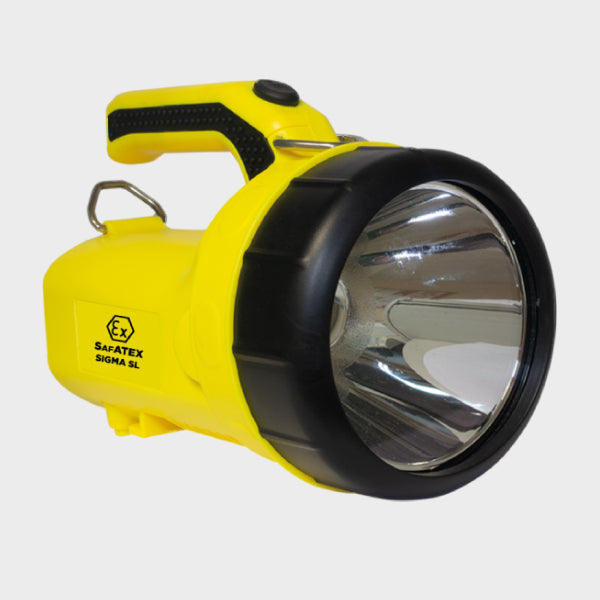Endüstriyel Güvenliğin Değişken Dünyasında Yol Almak
Endüstriyel güvenlik alanında, bir parametre felaket olaylarına karşı bir koruyucu olarak öne çıkar: Maksimum Patlama Basıncı (Pmax). Bu kritik ölçüm, yanıcı malzemelerin bulunduğu ortamlarda sağlam güvenlik sistemleri tasarlamanın temel taşıdır. Peki Pmax tam olarak nedir ve sizin için neden önemlidir?
Güvenlik ile felaket arasındaki farkın saniyenin kesirleri ve inç kare başına pound cinsinden ölçüldüğü bir dünyayı hayal edin. İşte Pmax dünyası budur – patlayıcı kuvvetleri anlamanın ve kontrol etmenin, normal bir iş günü ile manşetlere çıkan bir olay arasındaki fark anlamına gelebileceği bir dünya.
Maksimum Patlama Basıncının inceliklerini derinlemesine incelerken, bu hayati kavramın her şeyin tasarımını nasıl şekillendirdiğini keşfedeceğiz. patlamaya dayanıklı ekipman ile ATEX aydınlatmaEndüstrilerin patlayıcı potansiyel karşısında güvende kalmasını sağlayan bilim, uygulamalar ve son teknolojiler yolculuğuna katılın.
Pmax Essentials: Maksimum Patlama Basıncına Kılavuzunuz
Maksimum Patlama Basıncını (Pmax) anlamak, potansiyel olarak patlayıcı ortamlarda çalışan herkes için hayati önem taşır. Bunu kolayca sindirilebilen parçalara ayıralım.
📌 Pmax Nedir?
Pmax, belirli test koşulları altında kapalı bir kapta yanıcı bir maddenin (toz, gaz veya buhar) patlaması sırasında ulaşılan en yüksek basınçtır. Bunu bir patlamadaki "en kötü durum senaryosu" basıncı olarak düşünün.
🔍 Pmax Nasıl Ölçülür?
- Özel kaplarda (genellikle 1m³ veya 20 litrelik küreler) kontrollü patlamalar
- Yüksek teknolojili basınç sensörleri basınç değişikliklerini kaydeder
- Bazen patlamayı görselleştirmek için yüksek hızlı kameralar veya lazerler kullanılır
🌡️ Pmax'ı Etkileyen Nedir?
Pmax okumalarını etkileyebilecek birkaç faktör vardır:
- Parçacık boyutu (toz patlamaları için)
- Karışım ne kadar türbülanslı?
- Başlangıç basıncı ve sıcaklığı
- Mevcut oksijen miktarı
- Havadaki veya maddedeki nem
🛠️ Pmax Neden Önemlidir?
Pmax'ı bilmek şunlar için önemlidir:
- Güvenli havalandırma sistemleri tasarlamak
- Ekipmanın olası patlamalara dayanıklı olduğundan emin olmak
- Etkili baskılama sistemleri oluşturma
- Tehlikeli alanlarda risklerin değerlendirilmesi
- Patlayıcı ortamların doğru sınıflandırılması
🔐 Pmax Aksiyonda: Güvenlik Ekipmanları
Pmax bilgisi, şu gibi hayati öneme sahip güvenlik ekipmanlarının oluşturulmasına yardımcı olur:
- ATEX kameralar tehlikeli alanların güvenli bir şekilde izlenmesi için
- Patlamaya dayanıklı aydınlatma patlamalara neden olmayacak
- Diğer patlamaya dayanıklı aletler tehlikeli ortamlarda çeşitli görevler için
💡 Hızlı İpucu
Unutmayın: Potansiyel olarak patlayıcı alanlardaki ekipmanlar her zaman o ortamın Pmax'ından daha yüksek basınçlara dayanacak şekilde derecelendirilmelidir. Bu, içine koymayı planladığınızdan daha fazla su tutabilen bir kap seçmek gibidir - tedbirli olmak pişman olmaktan iyidir!
Pmax prensiplerini anlayıp uygulayarak yalnızca sayılarla çalışmıyorsunuz – kendiniz ve meslektaşlarınız için daha güvenli bir çalışma ortamına aktif olarak katkıda bulunuyorsunuz. Tehlikeli alanlarda gezinirken bu bilgiyi aklınızda bulundurun ve operasyonlarınızda her zaman güvenliğe öncelik verin.
Pmax Safety: Patlamaya Karşı Dayanıklı Temel Ürünler
Maksimum Patlama Basıncını (Pmax) anlamak, tehlikeli ortamlarda güvenliği sağlamak için çok önemlidir. Pmax, belirli koşullar altında bir patlama sırasında elde edilen en yüksek basıncı temsil eder ve potansiyel olarak patlayıcı ortamlar için ekipman tasarlama ve seçmede kritik bir faktördür.
Aşağıdaki tabloda, yüksek Pmax ortamlarında güvenli bir şekilde çalışmak üzere özel olarak tasarlanmış bir dizi patlamaya dayanıklı ürün gösterilmektedir. Bu ürünler, bir patlama sırasında oluşabilecek aşırı basınçlara dayanacak şekilde tasarlanmıştır ve bu da felaket niteliğindeki arızaları önlemeye ve hem personeli hem de tesisleri korumaya yardımcı olur.
ATEX kameralar ve termal görüntüleyiciler gibi izleme ekipmanlarından iletişim cihazlarına ve el fenerleri ve klavyeler gibi temel araçlara kadar her ürün, patlama risklerinin mevcut olduğu yerlerde güvenliği sağlamada hayati bir rol oynar. Bu Pmax dereceli ürünleri kullanarak, endüstriler operasyonel sürekliliği sağlarken patlayıcı atmosferlerle ilişkili riskleri önemli ölçüde azaltabilir.
| Ürün Adı | Ürün Görseli | Pmax Güvenliğinin Önemi |
|---|---|---|
| Armadex atex kamera |  |
Yüksek basınçlı patlayıcı ortamlarda güvenli izlemeyi sağlar, Bölge 1 ve 2 tehlikeli alanlarda Pmax'a dayanacak şekilde tasarlanmıştır. |
| Atex tehlikeli maddeler konteyner |  |
Yüksek Pmax'a katkıda bulunabilecek maddelerin tutulması açısından kritik öneme sahip olup, patlayıcı koşullara yol açabilecek maddelerin salınımını önler. |
| FLIR CX5 Termal Görüntüleme Kamerası |  |
Patlamaya yol açabilecek koşulların önlenmesi için sıcaklık izleme olanağı sağlar, yüksek Pmax potansiyeli olan ortamlarda kullanıma uygun olarak sertifikalandırılmıştır. |
| Atex wi-fi anteni |  |
Pmax'ın kritik faktör olduğu bölgelerde haberleşmeyi sağlar, yüksek patlama basınçları altında bütünlüğü koruyacak şekilde üretilmiştir. |
| Ecom smart-ex 02 dz1 |  |
Patlama riskinin en yüksek olduğu bölgelerde güvenli mobil iletişime olanak sağlar, Pmax potansiyeli yüksek Zone 1 tehlikeli bölgeler için tasarlanmıştır. |
| Gece Aramacısı SAFATEX SL |  |
Yüksek Pmax koşulları gibi yüksek basınçlara dayanıklı, yüksek riskli patlayıcı ortamlarda aydınlatma sağlar. |
Yukarıda listelenen her ürün, yüksek Pmax seviyelerinin risk oluşturduğu yerlerde güvenliğin sağlanmasında önemli bir rol oynar. Bu basınçlara dayanacak şekilde tasarlanmış ekipmanları seçerek, endüstriler güvenlik protokollerini iyileştirebilir ve personeli ve tesisleri patlamaların yıkıcı sonuçlarından koruyabilir.
Patlamaya dayanıklı ürün yelpazemiz ve bunların yüksek Pmax ortamlarında güvenliği nasıl artırabileceği hakkında daha fazla bilgi için, Specifex.com'u ziyaret edin Bugün.
Çözüm
Maksimum Patlama Basıncı (Pmax) sadece bir sayıdan daha fazlasıdır; tehlikeli ortamlar için ekipman tasarlama ve seçmede kritik bir faktördür. Pmax'ı anlayarak ve yüksek patlama basınçlarına dayanacak şekilde tasarlanmış ürünler seçerek, endüstriler güvenlik önlemlerini artırabilir ve felaket olaylarına karşı koruma sağlayabilir. Patlamaya dayanıklı kameralar, aydınlatma veya iletişim cihazları olsun, her ürün Pmax risklerinin mevcut olduğu yerlerde güvenliği sağlamada hayati bir rol oynar.
Potansiyel olarak patlayıcı ortamlarda faaliyet gösteren endüstriler için Pmax güvenliğine öncelik vermek yalnızca bir öneri değil, bir zorunluluktur. Doğru ekipmana yatırım yaparak ve Pmax prensipleri hakkında bilgi sahibi olarak, kuruluşlar riskleri azaltabilir ve dahil olan herkes için daha güvenli çalışma ortamları yaratabilir.
Pmax dereceli ürünlerimizin yelpazesini keşfedin Specifex.com ve yüksek basınçlı patlayıcı ortamlarda güvenliğinizi nasıl artırabileceğimizi keşfedin.

